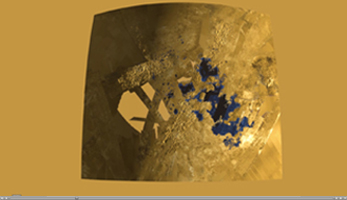Flying over an Extraterrestrial Land of Lakes
 | |
| Unannotated | |
| Annotated |
This colorized flyover movie from NASA's Cassini mission shows the two largest seas on Saturn's moon Titan and nearby lakes. Titan is the only world in our solar system other than Earth that has stable liquid on its surface. The liquid in Titan's lakes and seas is mostly methane and ethane.
The flight path starts at Titan's largest sea, Kraken Mare (about 680 miles or 1,100 kilometers long), and passes over the second largest sea, Ligeia Mare. Titan seas are named after sea monsters in world mythology. Then, there is an area with no topographical data and the flight path crosses an area with smaller lakes.
Lakes in this area are about 30 miles (50 kilometers) across or less.
Data for the movie was obtained by Cassini's radar instrument from 2004 to 2013. Heights of features were exaggerated 10 times. In this color scheme, liquids appear blue and black. Land areas appear yellow to white. A haze was added to simulate the Titan atmosphere.
Straight lines in the images are artifacts of how Cassini obtained the data.
The topographic mapping of Titan using stereo radar images was performed by the U.S. Geological Survey in Flagstaff, Ariz. The animation was created at JPL.
The Cassini-Huygens mission is a cooperative project of NASA, the European Space Agency and the Italian Space Agency. NASA's Jet Propulsion Laboratory, a division of the California Institute of Technology in Pasadena, manages the mission for NASA's Science Mission Directorate, Washington, D.C. The Cassini orbiter was designed, developed and assembled at JPL. The radar instrument was built by JPL and the Italian Space Agency, working with team members from the United States and several European countries.
For more information about the Cassini-Huygens mission visit http://saturn.jpl.nasa.gov and http://www.nasa.gov/cassini.
